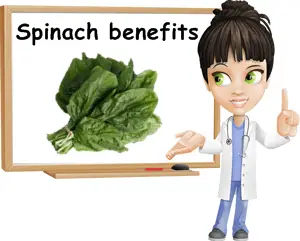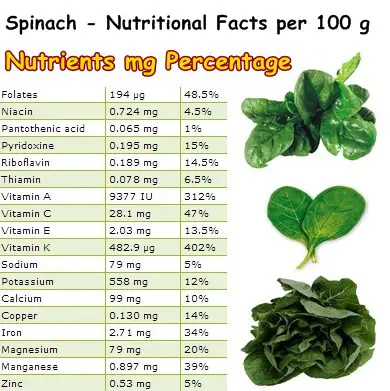Spinach is, without a doubt, one of the healthiest vegetables on the planet. Spinach can provide the body with great amounts of nutrients, vitamins, minerals and antioxidants, which help strengthen the bones, stimulate the immune system, reduce inflammation and prevent free radical damage. As portrayed in the famous children’s animation, Popeye the Sailor Man, spinach basically makes you strong and healthy not only because the leafy green boasts a generous nutritional value, but also because its nutrients are highly bioavailable.
Nutrition facts and benefits of Spinach
The rather impressive properties and health benefits of spinach make it a wonderful addition to any diet. Spinach, or Spinacia oleracea, is a beautiful green leafy vegetable with outstanding nutritional value. Spinach boasts a high concentration of carotenoids and flavonoids, phytochemicals with powerful anticancer, antioxidant and anti-inflammatory properties. Research suggests that spinach contains more than a dozen different flavonoid compounds which act as potent anti-inflammatory and anticancer agents.

Concentrated spinach extracts are presently used in controlled laboratory studies and appear to successfully slow down cell proliferation in both stomach cancer and skin cancer. A study conducted in the 1980s in New England came to the conclusion that women who increased their spinach intake considerably had up to 80% less chances of developing breast cancer. This adds amazing cancer-fighting abilities to the list of spinach health benefits.
Spinach is a great antioxidant food as well. Most of the nutrients and phytochemicals it contains, flavonoids, carotenoids, vitamin K, vitamin C, manganese, zinc and selenium, all offer amazing protection against free radical damage. Free radicals are harmful agents which cause DNA damage, cell mutations, abnormal division of cells and inflammation, all of which lead to premature aging, inflammatory diseases, cardiovascular disease and cancer.
Eating foods rich in antioxidants such as blueberries, yellow raspberries, grapes, walnuts, sunflower seeds, spinach and so on helps counteract and prevent free radical damage to our body. Think about what happens to an apple after you take a bite out of it. The inside of the fruit reacts with the oxygen in the air and slowly starts to brown (or oxidize). The same would happen to us if we didn’t have antioxidants to protect us.

Our blood vessels for example, are highly susceptible to damage caused by oxidation, which is why it is very important that we consume foods rich in antioxidants. Spinach has been linked to a reduced risk of atherosclerosis and hypertension. Spinach is particularly good for the heart because it inhibits the activity of a special peptide hormone called angiotensin, which is responsible for vasoconstriction (or shrinking of the blood vessels). Vasoconstriction leads to high blood pressure. By inhibiting the activity of angiotensin, spinach successfully regulates blood pressure.
The popular children’s animation, Popeye the Sailor Man, made it known to everyone that spinach is an extraordinary source of iron. 100 g of fresh spinach meets about 34% of the daily requirements of iron. One or two helpings of steamed or quickly boiled spinach can indeed provide a generous iron content, but not so much that you get instant muscles and Popeye strength. It can however significantly reduce fatigue, muscle weakness, increase concentration, stimulate immunity and help with anemia.
Aside from a generous iron content, spinach contains good amounts of magnesium (20%) and potassium (12%), two important dietary minerals which work together to ensure the good functioning of the heart, muscles and circulatory system. Magnesium supports muscle function, heart included, while potassium regulates blood pressure and body fluids.
Also, spinach is a rich source of manganese, a mineral with antioxidant effects. Here’s something interesting: 100 g of spinach contains 99 mg of calcium, about 10% of the recommended daily intake, making spinach one of the 10 richest sources of calcium.

But although fresh spinach is one of the richest sources of iron and calcium, it also contains a compound called oxalate which binds to both iron and calcium, significantly decreasing their absorption. Cooking spinach for about 2-5 minutes significantly reduces oxalate levels which helps maximize nutrient absorption. Soluble oxalate can be found in spinach, star fruit, poppy seeds, beets, some nut and bean varieties and is believed to be responsible for 3/4 of all kidney stone cases. It would appear that the best cooking method used to reduce oxalate content is boiling, followed closely by steaming.
But spinach boasts even more health benefits. By supplying the body with almost half of the daily vitamin C intake, spinach stimulates immunity, helps reduce inflammation and maintains a tight, young skin by supporting collagen production. Even more amazing is the fact that 100 g of fresh spinach provides 312% of daily vitamin A requirements and 402% of daily vitamin K requirements. Spinach contains both vitamin A proper and beta-carotene, lutein and zeaxanthin, provitamin A carotenoids with powerful antioxidant activity.
What does this mean? It means that a regular consumption of spinach sustains growth and development, ensures healthy hair, skin and mucous membranes and great vision. Even more, provitamin A carotenoids protect the retina from damage caused by free radicals found in blue light, thus preventing central vision loss associated with old age. The incredible amounts of vitamin K found in spinach support bone and cardiovascular health by preventing bone loss, bone fractures and arterial calcification.
What does spinach look and taste like?
Spinach has large, dark green leaves with a smooth surface. The leaves are ovate or egg-shaped, that is, slightly wider at the base, near the stem. The leaves are edible raw and cooked, but best cooked to reduce oxalate content and prevent associated side effects such as kidney problems. Baby spinach is more tender and has a less pronounced taste with pleasant green flavor notes which welcome consumption in salads as a raw leafy green. Older spinach is tougher and has a more pregnant bitter leafy green taste which is why it’s preferred cooked. Cooked spinach is mushy and watery with a slight tangy taste and pleasant green flavors.
How to choose and cook spinach
As it is the case with all foods, choosing them right makes a great deal of a difference in terms of health benefits. So here are a few important aspects to consider when it comes to spinach:
- Always buy spinach from local brands or small producers.
The smaller the producer, the more likely the spinach is fresh (the distribution chain is greatly reduced) and possibly also less likely it is heavily contaminated with pesticides (pivotal for producing good yields).
- Always choose frozen spinach over days-old fresh spinach.
Spinach loses most of its nutrients in a matter of days and the so-called fresh spinach found at the local supermarket might have been harvested 2 days or even one week before. Frozen spinach, however, maintains most of its nutrients as a result of the fact that it undergoes quick processing in a matter of hour following harvesting.
- Always choose bright, deep green spinach varieties over pale green ones.
The deep green pigmentation indicates a much higher chlorophyll content and a fresher spinach. Pale green or yellow leaves indicate the spinach has been harvested for some time and is likely to have lost some of its nutrition.
- Don’t overcook your spinach.
Overcooking spinach causes a massive loss of nutrients. Slowly simmer for at least 2-3 minutes or up to 10 minutes and you’re done cooking. Since the leaves shrink down anyway during cooking, it’s best to add just a little water at first. This way you can better time the process.
- Home-grown is always best.
If possible, grow your own delicious, organic, free spinach. It is sure to be jam packed with nutrients with great properties and health benefits and you will definitely see the difference in terms of energy and general well-being in just a few minutes.
